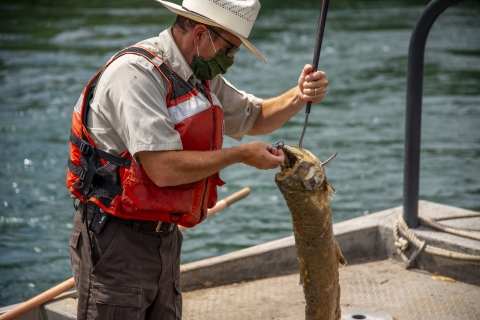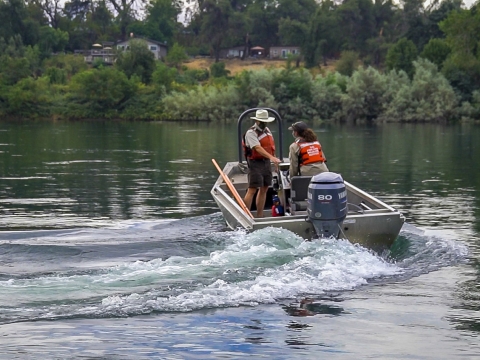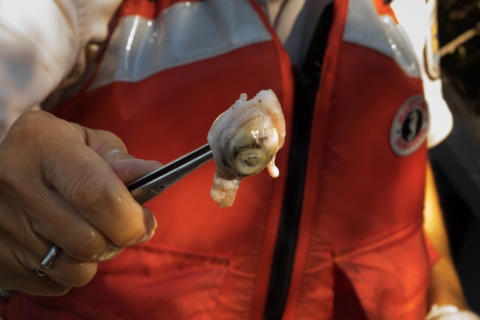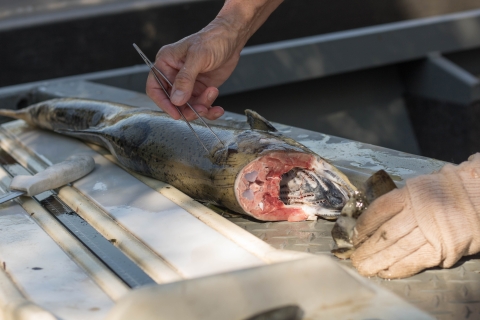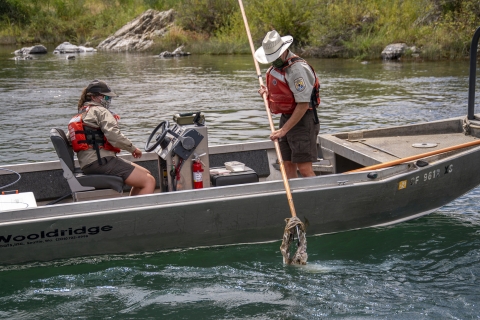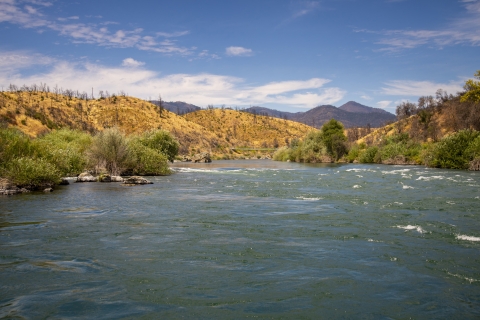The feel of the wind in your face, the sound of a boat motor roaring down a river, the spray of water, the warm sun on your back and the smell of rotting flesh. This is what the U.S. Fish and Wildlife Service biologists on the Sacramento River experience when conducting winter-run Chinook salmon carcass surveys.
“The carcass survey is a cooperative effort between the Service, the California Department of Fish and Wildlife, and the Pacific States Marine Fisheries Commission,” said Kevin Niemela, a Service supervisory fish biologist located at the Red Bluff Fish and Wildlife Office. “Typically, two boats are used to survey the river daily, one operated by the Service and the other operated by PSMFC working under contract through the Department. Each boat travels upstream and searches for carcasses, covering opposite shorelines.”
The survey allows the Service to get an idea of how many fish are returning, and where they came from. Once a salmon carcass is spotted, the boat team will use a gig on a long pole to pull the carcass into the boat, which can be more challenging than it sounds. The boat pilot has to battle water current and clarity to keep their eye on the carcass while getting into the correct position for their partner to get the fish on board the boat.
“We go out, assess and count the number of carcasses, and we also collect biological data from eyeballs, scales and fin tissue,” said Charlee Cramer, a fish biologist with the Service. “With that, we can see where they’ve been and where they came from, and we also can get a count of how many hatchery fish are out there. There will be some that have their fin clipped, which are hatchery fish, and some that are not clipped. Based on that, we can tell the percentage of hatchery success.”
Hatcheries improve the survival of young salmon (eggs, fry and juveniles). More young salmon survive in the hatchery than would survive in the wild because there are no predators in hatcheries, food is abundant and the environment is relatively constant.
“One important reason that we do the surveys is so that we can evaluate what Livingston Stone National Fish Hatchery is producing and how the fish are doing,” said Curtis Brownfield, a fish biologist with the Service. “We will clip and tag them up there at the hatchery and release them into the river. When they come back, we can pull the coded wire tag out of their snout and find out where they came from.
“Almost all of the hatchery fish came from Livingston Stone except a few strays, maybe from the Feather River State Hatchery, but all the rest are produced naturally here. This year, quite a bit of the population came from Livingston Stone. It might be half-and-half natural versus hatchery this year.”
Just because this year was a successful run, with the largest number of winter-run carcasses counted since 2006, does not mean next year will be. The surviving juveniles from this year’s spawning group will come back in three years. The fish that returned this year were fry or very small fish three years ago, this time of year. After emerging from the gravels, they out-migrated to the Delta, and then to the ocean in March of 2017, and spent two and a half years in the ocean before starting their upstream migration.
The juveniles from this year have a perilous journey between here and the ocean. There are many potential obstacles in their way, including lethal water temperatures, water flow, weather and predators. They also face obstacles to survival in the ocean, as well as the journey back to their spawning grounds.
The number of fish that returned this year was so high that for several days this year the agencies doubled the number of boats from two to four per day.
“In July and early August, we would have been out here until 7 p.m., picking up fish in 100-degree weather, and today at the end of August, we have very few fish, and it’s overcast,” said Brownfield. “It’s just always interesting to me how it just takes that plunge from a lot of fish to basically no fish.
“This year, we had a lot of fish, which might be due to the river’s clarity. With the river being very clear this year, we can see fish at a depth that normally we cannot. This year we’ve been able to cover more of the river and see more fish, due to that clarity.”
With the need for more boats on the water, partners play a huge role in the survey’s success.
“Our partners are incredible,” said Cramer of California Department of Fish and Wildlife, and Pacific States Marine Fisheries Commission. “The partners actually go out and collect carcasses all year round. They collect fall-run and late fall-run also. We help them mainly in the summer. Without them, we would be out here multiple days on each reach. We have three different stretches of river that we do every single day, so we do one side of the river, and they do the other. If we did not have them, it would be an even longer day out here — very long. They are extremely knowledgeable, and it’s really nice to work with them.”

